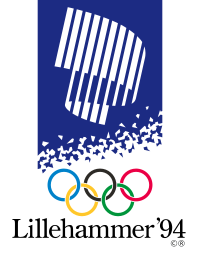
Back Лиллехаммер 1994 AB Olimpiese Winterspele 1994 AF Chuegos Olimpicos d'hibierno de 1994 AN الألعاب الأولمبية الشتوية 1994 Arabic Xuegos Olímpicos de Lillehammer 1994 AST 1994 Qış Olimpiya Oyunları AZ Зімовыя Алімпійскія гульні 1994 BE Зімовыя Алімпійскія гульні 1994 году BE-X-OLD Зимни олимпийски игри 1994 Bulgarian Jocs Olímpics d'Hivern de 1994 Catalan
 Emblem of the 1994 Winter Olympics[a] | |
| Host city | Lillehammer, Norway |
|---|---|
| Motto | Fire in your heart (Norwegian: Se ilden lyse) |
| Nations | 67 |
| Athletes | 1,737 (1,215 men, 522 women) |
| Events | 61 in 6 sports (12 disciplines) |
| Opening | 12 February 1994 |
| Closing | 27 February 1994 |
| Opened by | |
| Cauldron | |
| Stadium | Lysgårdsbakken |
Winter Summer
1994 Winter Paralympics | |
| Part of a series on |
| 1994 Winter Olympics |
|---|
The 1994 Winter Olympics, officially known as the XVII Olympic Winter Games (Norwegian: De 17. olympiske vinterleker; Nynorsk: Dei 17. olympiske vinterleikane) and commonly known as Lillehammer '94, was an international winter multi-sport event held from 12 to 27 February 1994 in and around Lillehammer, Norway. Having lost the bid for the 1992 Winter Olympics to Albertville in France, Lillehammer was awarded the 1994 Winter Games on 15 September 1988, two days before the 1988 Summer Olympics opening ceremonies at the 94th IOC Session in Seoul, South Korea. Due to the calendar changes made in 1985, this was the only time that the Winter Olympics took place two years after the previous Winter Games, and the first to be held in a different year from the Summer Olympics. This was the second Olympic Games of any type hosted in Norway — the first being the 1952 Winter Olympics in Oslo — and the fourth Olympics overall to be held in a Nordic country, after the 1912 Summer Olympics in Stockholm, Sweden, and the 1952 Summer Olympics in Helsinki, Finland. As of 2022, Lillehammer is the northernmost city ever to host the Olympic Games and also the smallest. This was the last of three consecutive Olympics held in Europe, with Albertville and Barcelona in Spain hosting the 1992 Winter and Summer Games, respectively.
Although Lillehammer was the main host city, some events were held in neighboring cities and counties, and the speed skating events were held in Hamar, some ice hockey matches were played in Gjøvik, and the Alpine skiing events were held in Øyer and Ringebu areas. Sixty-seven National Olympic Committees and 1,737 athletes participated in six sports and sixty-one events.[1] Fourteen countries made their Olympic debuts, of which nine were former Soviet republics. The Games also saw the introduction of stricter and more rigid qualifying rules, reducing the number of under-performing participants. Six new events were introduced into the Olympic programme: new distances in short track speed skating and aerials, while International Skating Union (ISU) turned compulsory that the speed skating events in Olympics had to be indoors. Almost two million people spectated at the Games, which were the first to have the Olympic Truce in effect. The Olympics were succeeded by the 1994 Winter Paralympics from 10 to 19 March.
Manuela Di Centa and Lyubov Yegorova dominated women's cross-country skiing, taking five and four medals for Italy and Russia respectively. A crowd of more than 100,000 saw Italy beat Norway by 0.4 seconds in the men's 4 × 10 km relay. Vreni Schneider won a complete set of medals for Switzerland in Alpine skiing, while Norway took a podium sweep in the men's combined competition. Figure skater Nancy Kerrigan won silver in ladies' singles, despite being attacked a few weeks before the Games by Tonya Harding's associate Shane Stant; 16-year-old Oksana Baiul edged Kerrigan to win the gold medal, marking the first time the Ukrainian national anthem was played at the Olympics. Johann Olav Koss won three speed skating golds for Norway, while 13-year-old Kim Yun-mi from South Korea became the youngest-ever Olympic gold medalist. Sweden defeated Canada in a dramatic penalty shootout in the ice hockey final. Russia won the most events, with 11 gold medals, while Norway collected the highest number of medals overall, winning 26.
Cite error: There are <ref group=lower-alpha> tags or {{efn}} templates on this page, but the references will not show without a {{reflist|group=lower-alpha}} template or {{notelist}} template (see the help page).
- ^ "The Olympic Winter Games Factsheet" (PDF). International Olympic Committee. Archived from the original (PDF) on 5 August 2011. Retrieved 5 August 2012.